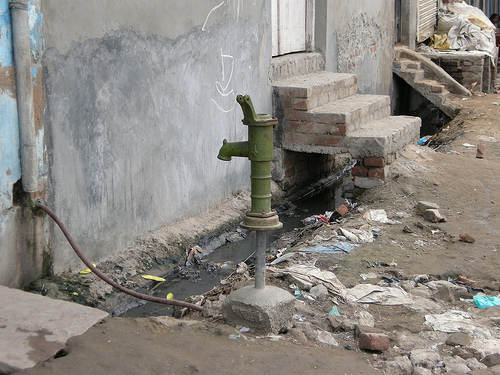Coauthor, Nicolas Dickinson, IRC International Water and Sanitation Centre
$25 Can't Give Someone Clean Water for Life: The Real Cost of Sustainable Service
Water, sanitation, and hygiene (WASH) development organizations are often asked by donors to quantify their projects in terms of unit cost or cost per beneficiary. With more focus these days on evidence base, outcome contracting, and sustainability, it's time to develop a more comprehensive approach that includes looking at life-cycle costs for WASH programs. This is a direct challenge to a cost-per-beneficiary-per-project approach, which oversimplifies what it takes to get the job done properly and for the long term.
IRC International Water and Sanitation Centre and WASHCost project partners have been doing critical work to quantify life-cycle costs. They have developed a water and sanitation service costing framework called the life-cycle cost approach, which outlines the complexity of costs to provide safe, affordable, and sustainable drinking water for populations over time.
Life-cycle costs are the aggregate costs of ensuring delivery of adequate, equitable, and sustainable WASH services to a population in a specified area. This approach takes into account both the initial onetime investment to establish or significantly extend a service (Capital Expenditure) and the recurrent costs.
Understanding these life-cycle costs will help governments, donors, and organizations plan better, determine priorities, identify gaps in support, and choose appropriate partners. This approach also provides a way to demonstrate the leveraging of resources.
The major problem with the unit-cost/cost-per-beneficiary approach is that it usually refers to onetime construction costs (Capital Expenditure) and disregards many of the life-cycle costs, especially those recurring and unexpected costs (like Capital Maintenance Expenditure) that will take place over the next 1 to 20 years. Unfortunately, Capital Expenditure alone does not lead to a better WASH system. For example, according to WASHCost research from Andhra Pradesh, India, an estimated 30% of investments became ineffective due to improper maintenance.
The other issue the life-cycle cost approach takes into account is levels of service. In other words, it's important to make sure a financial contribution actually results in improving water, sanitation, and hygiene services for people who have poor service or lack access to services altogether.
In addition to knowing what it costs to deliver a service, it is important to define the service itself in terms of the level of service (judged against agreed indicators) that is supposed to be delivered, and that users actually receive.
If these costs are not considered and paid, projects fail and one must start from scratch. Such projects cost much more than if life-cycle costs were determined in the beginning. Rehabilitation and recurrent costs must be dealt with before services completely fail in order to ensure that false promises are not made.
For example it is clearly more cost-effective to replace a $500 handpump every 5 to 10 years than to wait for it to fail and then develop a new $10,000 borehole.
Water For People has created a strategy called "Everyone and Forever," which aims to achieve full coverage in the districts in which it works and to ensure that mechanisms are in place to sustain an adequate level of service over time. With the support of the World Water Corps, Water For People is developing a tool its teams can use to quantify life-cycle costs. It starts with a financial contribution for a specific geographic region to achieve a level of service, but this amount will change over time depending on how much is leveraged with national and local government financial expenditures, tariffs collected, and other factors. Ideally, Water For People's contribution decreases over time, but there are still costs that must be paid.
Organizations like Water For People and the IRC International Water and Sanitation Centre are only beginning to obtain data on life-cycle costs in the countries where they work, and are finding widely varying expenditures across different countries and environments (urban, rural, dry, wet). The cost of full system replacement 20 years from now, plus planning and programming for ongoing costs, can only be roughly estimated at this time. Although it's probably possible to determine a cost per person (per year), time and resources must be invested to get the data on life-cycle costs in order to provide an accurate range of figures for a specific area.
If the data on life-cycle costs are missing (which is often the case), then a cost per unit is an incomplete number that, when used to market WASH programs to potential donors, amounts to false advertising. This is why $25 can't give someone clean water for life.
The amount of a financial contribution can be considered only when it is known how much a program that can achieve sustainable service provision would cost. The WASHCost project has determined some of the actual expenditures, but these are context specific and do not necessarily reflect ideal expenditures, because not all systems are fully functional or sustainable. WASHCost will explore ideal figures in coming publications. Furthermore, there will be ongoing costs per year--and it's not clear how cost per beneficiary can be calculated for these, if at all. Acknowledging long-term recurrent costs is critical if an intervention is to be successful.

Photo Courtesy of Steps Centre
WASHCost has found that one in three systems is not working, and in terms of level of service provided, the numbers are even worse. This failure is something potential donors, like those affiliated with WASHfunders.org, should be concerned about. If donors start thinking now about costs related to ongoing service delivery, and programming with these costs in mind, funds will be good contributions instead of money down the drain.